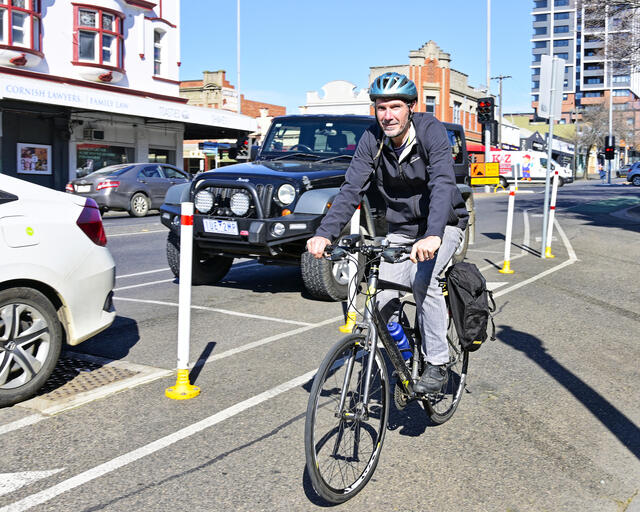Geelong resident Ashley Goldstraw had come to accept cycling in car-dominated areas like central Geelong was dangerous.
But two things spurred him to advocate for change.
“I had a minor altercation with a car last year; it pulled out in front of me on the bike lane on Moorabool Street coming out of West Fyans Street,” he said.
“I managed to slow down enough, but I still clipped the car. The bike went down; I didn’t go down, I stepped out and I was okay.
“That was one of the things that got me motivated to get moving. The other was my kids.
“My young teenage kids got into riding, gaining a bit of independence, but I just started thinking, I don’t know whether I want them riding out there.”
In addition to founding advocacy group Bike Geelong, Mr Goldstraw, who has cycled most of his life, launched his YouTube channel Bike Route Buddy in October last year.
It features weekly videos of Mr Goldstraw riding and reviewing areas and intersections of Geelong that could prove dangerous to other cyclists.
His most watched video has received more than 18,000 views.
“For something with such local content, it’s starting to get some traction and we’re starting to get a lot of views,” he said.
“Ultimately, the more people that see it, the more influence that has on campaigning for some change in and around the city.”
Geelong once had aspirations to become a cycling city. The Barwon Regional Strategic Bicycle Plan 1996 set the target of achieving 8 per cent of all journeys in the region by cycle by the year 2000 and 15 per cent by 2005.
The City of Greater Geelong followed up that plan with its Greater Geelong Cycle Strategy 2008, which proclaimed Geelong had the “potential to become a world class cycling city”.
In 2020 Geelong council decided to spend $2 million tearing up new separated bike lanes built as part of the Green Spine project, and has since indefinitely paused stage two of its Southern Bike Link.
In 2001, about 1.5 per cent of the region’s population rode to work on census day. In 2016 that percentage dropped to 0.8, and during the lockdowns in 2021 the number was just 811 people, or 0.6 per cent of the working population.
Mr Goldstraw said the cost of doing nothing would exceed the cost of implementing safe cycling infrastructure by “orders of magnitude”.
“Council needs to step up and provide more options for people to travel around town,” he said.
“They seem to be resistant to any improvements in cycling infrastructure, to the point where they actually want to rip stuff out. If they want to be local leaders and make Geelong a progressive global city, they need to follow what other global cities are doing.”
City of Greater Geelong’s executive director of placemaking Tennille Bradley said the council was currently developing an Integrated Transport Strategy (ITS) investigating broader strategies around a “holistic cycling, driving, pedestrian and public transport network”.
“The Greater Geelong Cycle Strategy was adopted in 2008, but since then, other transport related strategies, prepared by both the state government and the City, have reinforced the need for a safe and well-connected bicycle network to increase the number of people using a bike for transport and recreation,” Ms Bradley said.
“In June, we wrapped up Phase 1 of community engagement for the ITS to help guide decision-making on all forms of transport including cycling and support the region’s future transport needs.
“We’re analysing the feedback and a summary will be available on our Have Your Say page in due course.
“Part of developing the ITS is reviewing the Principal Bicycle Network and Strategic Cycling Corridors and further community engagement will take place in early 2025 as part of that review.”
Visit yoursay.geelongaustralia.com.au/ITS to view the progress of Geelong council’s Integrated Transport Strategy.







